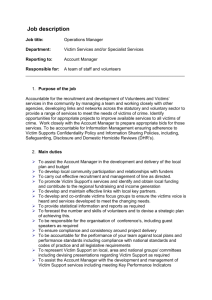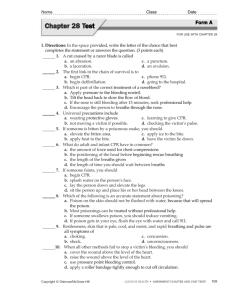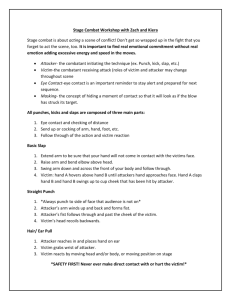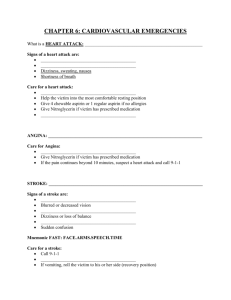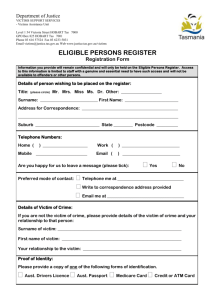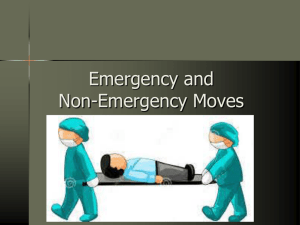Animal and Human Bites
advertisement
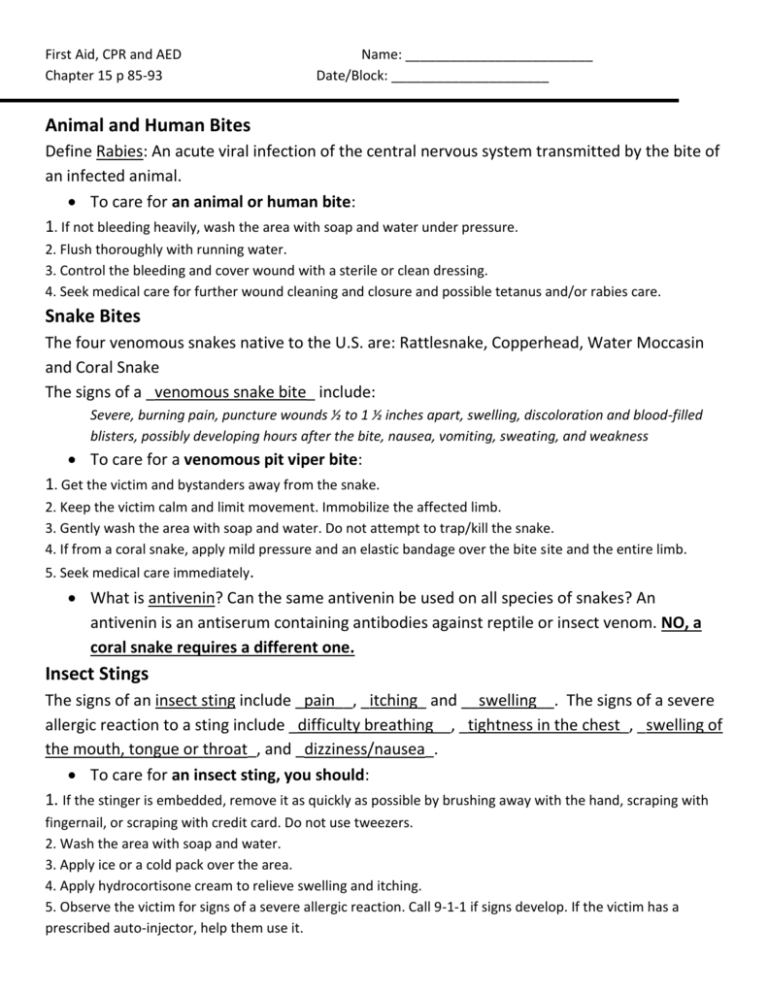
First Aid, CPR and AED Chapter 15 p 85-93 Name: _________________________ Date/Block: _____________________ Animal and Human Bites Define Rabies: An acute viral infection of the central nervous system transmitted by the bite of an infected animal. To care for an animal or human bite: 1. If not bleeding heavily, wash the area with soap and water under pressure. 2. Flush thoroughly with running water. 3. Control the bleeding and cover wound with a sterile or clean dressing. 4. Seek medical care for further wound cleaning and closure and possible tetanus and/or rabies care. Snake Bites The four venomous snakes native to the U.S. are: Rattlesnake, Copperhead, Water Moccasin and Coral Snake The signs of a _venomous snake bite_ include: Severe, burning pain, puncture wounds ½ to 1 ½ inches apart, swelling, discoloration and blood-filled blisters, possibly developing hours after the bite, nausea, vomiting, sweating, and weakness To care for a venomous pit viper bite: 1. Get the victim and bystanders away from the snake. 2. Keep the victim calm and limit movement. Immobilize the affected limb. 3. Gently wash the area with soap and water. Do not attempt to trap/kill the snake. 4. If from a coral snake, apply mild pressure and an elastic bandage over the bite site and the entire limb. 5. Seek medical care immediately. What is antivenin? Can the same antivenin be used on all species of snakes? An antivenin is an antiserum containing antibodies against reptile or insect venom. NO, a coral snake requires a different one. Insect Stings The signs of an insect sting include _pain__, _itching_ and __swelling__. The signs of a severe allergic reaction to a sting include _difficulty breathing__, _tightness in the chest_, _swelling of the mouth, tongue or throat_, and _dizziness/nausea_. To care for an insect sting, you should: 1. If the stinger is embedded, remove it as quickly as possible by brushing away with the hand, scraping with fingernail, or scraping with credit card. Do not use tweezers. 2. Wash the area with soap and water. 3. Apply ice or a cold pack over the area. 4. Apply hydrocortisone cream to relieve swelling and itching. 5. Observe the victim for signs of a severe allergic reaction. Call 9-1-1 if signs develop. If the victim has a prescribed auto-injector, help them use it. Spider Bites Black Widow spiders: females have a red hourglass shape on the abdomen, antivenin can provide relief. Brown Recluse spiders: have a violin shaped figure on their backs, results in a red blister and bull’s-eye pattern, leads to a scab and an ulcer. To care for ALL spider bites: 1. If possible, catch the spider to confirm its identity. 2. Wash the bitten area with soap and water. 3. Apply ice or a cold pack over the bite to relieve pain. 4. Seek medical care. To care for a tick bite: 1. Remove the tick with tweezers or a specialized tick removal tool. Grasp the tick as close to the skin as possible and lift the tick with enough force to “tent” the skin’s surface. Hold it in this position until the tick lets go. 2. Wash the area with soap and water or use an antiseptic. 3. Apply ice or a cold pack to reduce pain. 4. Seek medical care if the tick was attached for a few hours. Watch for signs of a transmitted disease such as a rash, fever, muscle and joint aches, or weakness. Marine Animal Injuries The three types of marine animals that bite, rip or puncture are: __sharks___ __barracudas___ __moray eels___ To care for marine animal bites, rips and punctures: 1. Control any bleeding. 2. Care for shock. 3. Call 9-1-1. The two types of marine animals that sting are: __jellyfish__ __Portuguese man-of-war___ To care for marine animal stings: 1. Carefully pick off any tentacles remaining on the skin. Use gloves if available. 2. Apply vinegar to jellyfish stings to neutralize nematocysts. 3. Immerse the affected part in hot water as soon as possible. 4. Seek medical care. How do stingrays inflict wounds on victims? What do the wounds look like? -Stingrays usually inflict injuries on the ankles or the feet of the victim when they get stepped on. There is a laceration caused by the large tail barb with intense burning pain. First Aid, CPR and AED Chapter 16 p. 94-97 Name: _________________________ Date/Block: _____________________ Heat Emergencies Condition Heat Cramps Heat Exhaustion Heat Stroke Definition Painful muscle spasms, often after physical exertion. Usually in the legs and sometimes in the abdomen. Condition caused by the loss of the body’s water and salt through excessive sweating; usually affects those who do not drink enough fluids while exercising, and those not acclimated to hot, humid conditions. What to look for Steps of care 1. Stop activity and rest in cool area. Cramped muscles 2. Stretch and Pain massage muscle. 3. Provide water or sports drink. Heavy sweating 1. Stop activity and Severe Thirst rest in cool area. Weakness 2. Remove excess or Headache tight clothing. Nausea/Vomiting 3. Provide water or sports drink. Seek medical care 4. Lay victim down. for children and frail 5. Apply cool packs adults. to armpits and hip crease. DO/DO NOT place 6. Seek medical care victim in an ice bath if no improvement after 30 minutes. Life-threatening Extremely hot skin 1. Call 9-1-1. condition where the Dry skin (maybe 2. Cool the victim body becomes sweaty) immediately by dangerously Confusion whatever means overheated. Body’s Seizures possible: heat regulating Unresponsiveness -Cool, wet towels function does not -Fanning work properly, and - Cool/ice packs body cannot 3. If unresponsive SWEAT. and not breathing, begin CPR. Cold Emergencies Condition Frostbite Definition Tissue damage caused by extreme cold, only happens when temperatures drop below freezing (32oF) Usually affects: - Feet - Hands - Nose - Ears Dangerous condition caused by severe exposure to cold in which the body temperature drops below 95oF. What to look for White, waxy-looking skin Skin feels cold and numb (pain at first followed by numbness), and blisters which may appear after rewarming. Steps of care 1. Move the victim to a warm place. 2. Remove wet/cold clothing and jewelry from the injured part. 3. Seek medical care. DO/DO NOT rub or massage frostbitten area. Uncontrollable 1. Get the victim out shivering of the cold. 2. Prevent heat loss Hypothermia Confusion, by: sluggishness -Remove wet clothing - Cover victim’s head Cold skin even under - Placing insulation Can develop quickly clothing under/ over the in cold water or victim. slowly with 3. Have victim rest in prolonged exposure comfortable position to cold 4. Give warm, sugary temperatures beverages if victim is alert and able to swallow. 5. Seek medical care for severe cases. Prepare appropriately for hot and cold weather by following these guidelines: For a HOT environment For a COLD environment Wear lightweight, loose-fit clothes and a Layer moisture-wicking clothing under wide brimmed hat waterproof and windproof outer layers. Drink adequate amounts of water and sports drinks. Keep head and neck covered to minimize heat loss. Take breaks in cooler areas. Drink warm drinks and eat properly. First Aid, CPR and AED Chapter 17 p. 98-103 Name: _________________________ Date/Block: _____________________ Water Rescue To attempt a water rescue, use “_REACH__, _THROW__, _ROW_, __GO__.” Ice Rescue True/False: To rescue a victim who has fallen through ice, use a pole or throw a line with an inflatable object attached to it and pull the person towards the shore or edge of ice once they grab hold. Electrical Emergency Rescue Most indoor electrocutions are caused by faulty equipment or careless use. Before touching a victim, turn off the electricity at the circuit breaker, fuse box or outside switch box. Hazardous Materials, Car Crashes, and Fires Clues that indicate the presence of Hazardous Materials are: 1. Signs on vehicles (see warning sign slide) 2. Spilled liquids or solids 3. Strong, unusual odors 4. Clouds of vapor When approaching a motor vehicle crash: 1. Stop and park your vehicle in a safe area. Call 9-1-1. 2. Turn on your emergency hazard flashers and raise the hood of your vehicle to draw attention to the scene. 3. Make sure the scene is safe before approaching. 4. Ask the driver to turn off the ignition or do it yourself. 5. Place flares behind the crash scene to warn oncoming drivers. Beware of leaking gasoline or diesel fuel. 6. If there is a suspected spinal injury, use your hands to stabilize the victim’s head and neck. 7. Check and care for life threatening injuries first and then handle lesser injuries. To assist victims when a fire is present: 1. Get all people out of the area quickly. 2. Call 9-1-1. 3. If the fire is small and your own escape route is clear, fight the fire yourself with a fire extinguisher. 4. To use a fire extinguisher, aim directly at the base of the flames and sweep across. What is a confined space? List 5 examples of confined spaces. An area not intended for human occupancy that may have or develop a dangerous atmosphere. Manholes, utility vaults, storage tanks, silos, old mines and wells. To assist a victim in a confined space: 1. Call 9-1-1. 2. Check motionless victims first. Do not enter without proper training and equipment. 3. Once the victim is removed, provide care. Triage Define triage: the sorting of patients into groups according to the severity of injuries and used to determine priorities for treatment and transport. When identifying victims who need immediate care, start by asking all victims who can walk to get up and move to a specific area. Then, check all motionless victims for breathing and severe bleeding. Enlist bystanders to assist in opening airways or applying direct pressure to wounds. RAPIDLY move to the next victim. Do not spend more than 30 seconds at each victim. Once you have tended to the most severely wounded, go back and reassess for less serious injuries. Continue providing care until relieved by EMS. Classify victims according to the following care and transportation priorities: Immediate Care: Care right now! Breathing difficulties, severe bleeding, severe burns, signs of shock, unresponsiveness. Delayed Care: Care can be delayed up to one hour. Minor extremity burns, bone/joint injuries without severe bleeding, back injuries. Walking Wounded: Care can be delayed up to 3 hours. Minor fractures, minor wounds. Dead: Obviously dead or unlikely to survive due to the type or extent of the injuries. When should you attempt to move a victim? --Fire --Explosives/hazardous materials --Scene hazards -- To get to another victim


